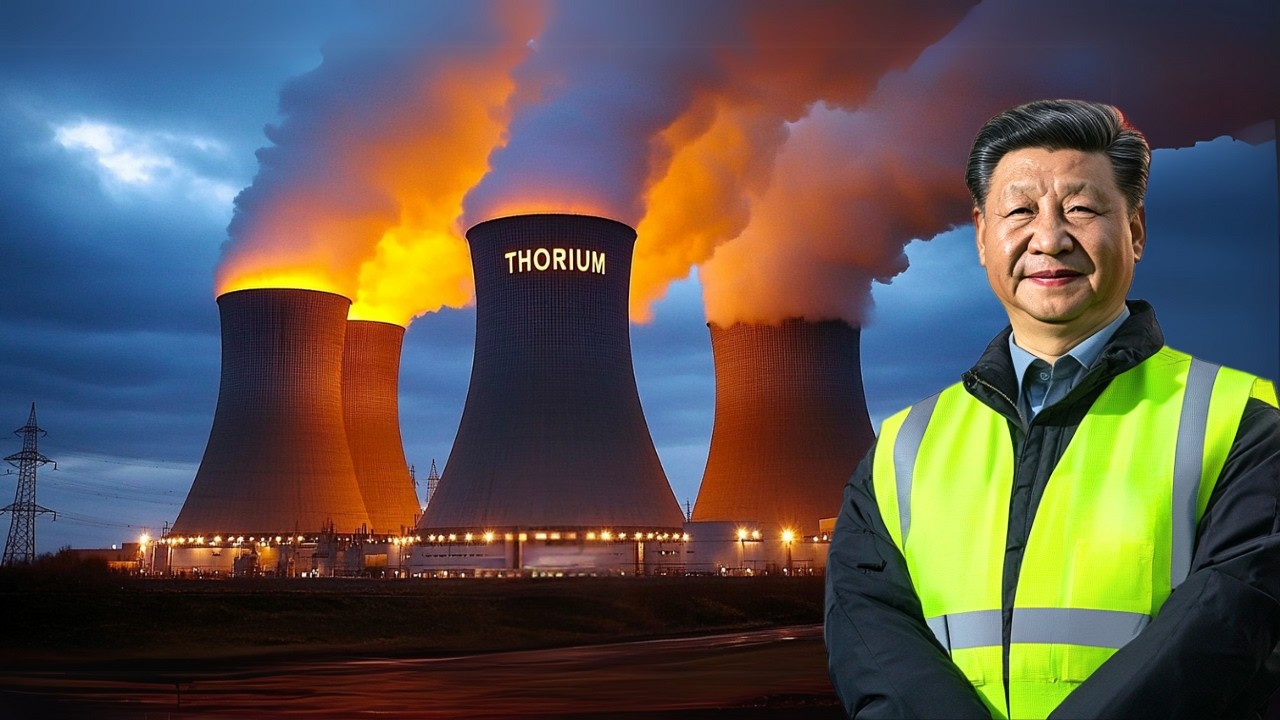China’s Thorium Nuclear Reactor: A Clean Energy Revolution Built on Forgotten U.S. Innovation
In a remote corner of the Gobi Desert, China has ignited a spark that could redefine the future of global energy. The world’s first operational thorium molten salt reactor (MSR), a 2-megawatt prototype, achieved a historic milestone by successfully reloading fuel while running—a feat no nation has accomplished before. This breakthrough, announced on April 8, 2025, at a closed-door meeting of the Chinese Academy of Sciences (CAS), marks a pivotal moment in nuclear innovation. What makes this achievement even more remarkable is its foundation: declassified U.S. research from the 1960s, abandoned in favor of uranium-based reactors. As China surges ahead, the United States and the world are left grappling with the implications of a cleaner, safer, and more abundant energy source. This article explores the technology, its history, and why China’s thorium reactor is sending shockwaves through the global energy landscape.

The Thorium Advantage: A Safer, Cleaner Nuclear Future
Thorium, a silvery, slightly radioactive metal, is three to four times more abundant in the Earth’s crust than uranium, with significant deposits in China’s Inner Mongolia that could theoretically power the nation for tens of thousands of years. Unlike uranium, thorium produces less long-lived radioactive waste, reducing the environmental burden of nuclear power. Its byproducts are also less suitable for weaponization, lowering proliferation risks—a critical advantage in a world wary of nuclear security threats. When paired with molten salt technology, thorium reactors operate at atmospheric pressure, minimizing the risk of meltdowns and enhancing safety. These features make thorium MSRs a compelling alternative to traditional uranium-based reactors, which rely on pressurized water and solid fuel rods.
The Gobi Desert reactor, known as TMSR-LF1 (Thorium Molten Salt Reactor – Liquid Fuel 1), uses a liquid mixture of thorium and uranium fluorides dissolved in molten salt as both fuel and coolant. This design allows for continuous operation and refueling without shutdowns, a stark contrast to conventional reactors that require periodic halts. The reactor achieved criticality in October 2023, reached full power by June 2024, and completed its first in-operation fuel reload in October 2024. This milestone demonstrates the practical viability of thorium MSRs, positioning China as the global leader in next-generation nuclear technology.
A Tale of Two Nations: From U.S. Innovation to Chinese Triumph
The story of thorium reactors begins not in China, but in the United States. In the 1950s and 1960s, scientists at Oak Ridge National Laboratory pioneered molten salt reactor technology, running a successful experimental MSR from 1965 to 1969. Despite its promise—safer operation, reduced waste, and abundant fuel—the U.S. abandoned thorium research in favor of uranium-based reactors, which aligned with Cold War priorities like nuclear weapons development and submarine propulsion. The declassified research was left dormant, “waiting for the right successor,” as project chief scientist Xu Hongjie put it. China, seizing the opportunity, became that successor.
Since the 1970s, China has invested heavily in thorium research, with the CAS Shanghai Institute of Applied Physics leading the charge. Construction of the TMSR-LF1 began in 2018, supported by a team that grew to over 400 researchers. Many worked through holidays, monitoring critical parameters like neutron flux and temperature variations. Drawing on U.S. blueprints, the team replicated early experiments and pushed the technology further, solving challenges like molten salt corrosion and sustaining fission with thorium’s weaker radioactivity. Xu Hongjie, who took the helm in 2009, emphasized the team’s focus on real-world application over academic theory: “We chose the hardest path, but the right one.”
Why Thorium Matters: Environmental and Economic Impacts
China’s thorium reactor aligns with its ambitious goal of achieving carbon neutrality by 2060, a critical step for the world’s second-largest carbon emitter. Nuclear power, which emits no greenhouse gases during operation, is a cornerstone of this strategy. Thorium MSRs enhance this vision by producing minimal long-lived waste—dangerous for hundreds of years rather than thousands—and requiring less complex disposal systems. The reactor’s ability to generate 2 megawatts of thermal power in a compact, water-free design makes it ideal for remote regions like the Gobi Desert, where traditional cooling systems are impractical.
Economically, thorium’s abundance offers energy independence. A single mine in Inner Mongolia could supply China’s energy needs for millennia, reducing reliance on imported uranium or fossil fuels. The technology’s scalability also holds promise for global markets. China is already building a larger 10-megawatt thorium reactor, set to reach criticality by 2030, and plans commercial small modular reactors (SMRs) of at least 100 megawatts by the 2030s. Blueprints for thorium-powered container ships further signal China’s intent to decarbonize maritime transport, a sector responsible for significant global emissions.
Globally, thorium reactors could transform energy access. Developing nations, often rich in thorium deposits, could adopt this technology to meet growing energy demands without the risks associated with uranium. Countries like India, with vast thorium reserves, are advancing their own programs, while Norway and the U.S. are exploring similar technologies. The International Atomic Energy Agency (IAEA) is coordinating global research, recognizing thorium’s potential to complement renewable energy sources like solar and wind, which face challenges with intermittency.
The U.S. Response: A Wake-Up Call
China’s breakthrough has jolted the United States, where thorium research has seen a resurgence but lags behind. The U.S. Department of Energy, in collaboration with institutions like Texas A&M and Idaho National Laboratory, is developing thorium-based fuels like ANEEL (Advanced Nuclear Energy for Enriched Life), a combination of thorium and high-assay low-enriched uranium. Private companies like Flibe Energy and Core Power are also investing in MSRs, with plans for floating nuclear plants. However, regulatory hurdles, funding constraints, and a focus on conventional reactors have slowed进度. Analysts estimate China is 10 to 15 years ahead in deploying fourth-generation nuclear technologies.
The U.S. faces a stark choice: accelerate investment in thorium and advanced reactors or risk ceding leadership to China. Past attempts to revive thorium research, such as proposals by Senators Harry Reid and Orrin Hatch, have faltered due to budget cuts and political inertia. Meanwhile, China’s state-backed approach—combining financing, systemic coordination, and a willingness to build on foreign research—has proven effective. The irony is palpable: a technology born in America is now thriving in the Gobi Desert, potentially forcing the U.S. to import or license its own innovation.
Challenges and Criticisms
Despite its promise, thorium technology faces hurdles. The weak radioactivity of thorium-232 requires complex nuclear reactions to produce uranium-233, the fissile material that powers the reactor. Early U.S. experiments struggled with molten salt corrosion, a challenge China claims to have addressed, though details remain scarce. Operating in continuous mode, as the TMSR-LF1 plans to do after 5–8 years of batch mode, demands sophisticated systems for managing fission products and off-gases, technologies that are not yet fully mature.
Critics also raise concerns about transparency and safety. China’s closed-door announcement and limited publication of scientific results have sparked skepticism about the reactor’s performance and long-term viability. While thorium MSRs are designed to be meltdown-proof, any nuclear technology carries inherent risks, and public trust will be critical for global adoption. Additionally, the environmental impact of thorium mining and fuel processing, though less severe than uranium, requires careful management to avoid ecological harm.
A Global Energy Paradigm Shift
China’s thorium reactor is more than a technological feat—it’s a statement of intent. By reviving a forgotten U.S. innovation, China is positioning itself as the nucleus of next-generation nuclear research. The implications extend beyond energy to geopolitics. Thorium reactors could become tools of soft power, exported to energy-hungry nations along China’s Belt and Road Initiative. With plans for commercial plants and thorium-powered ships, China is setting new standards for clean energy, challenging Western dominance in nuclear technology.
For the global energy transition, thorium MSRs offer a path to decarbonization without the drawbacks of traditional nuclear power. Their compact design, passive safety features, and minimal waste make them a viable complement to renewables, particularly in regions with limited infrastructure. As climate change intensifies, the urgency of adopting such technologies grows. China’s success could shame other nations into action, spurring a global race to harness thorium’s potential.
Looking Ahead
The TMSR-LF1 is just the beginning. China’s roadmap includes a 60-megawatt pilot plant by 2029, capable of generating 10 megawatts of electricity and producing hydrogen through high-temperature hydrolysis. By 2030, commercial SMRs could power entire communities, while thorium-powered ships could revolutionize maritime transport. These ambitions reflect China’s long-term vision, one that contrasts with the short-term priorities that stalled thorium research in the West.
For the United States, the path forward requires bold investment and regulatory reform. Collaborations with allies like Canada, which has expertise in thorium-compatible CANDU reactors, could accelerate progress. Private sector innovation, supported by government funding, will be crucial to closing the gap with China. The stakes are high: energy security, climate goals, and technological leadership hang in the balance.
China’s thorium reactor is a modern moon landing—a triumph of persistence and vision. It proves that revisiting the past can yield transformative results, especially when paired with relentless execution. As the world watches the Gobi Desert’s quiet hum, one thing is clear: the future of nuclear energy is no longer a distant dream. It’s here, and it’s powered by thorium.





